Accuracy Improvement of Debonding Damage Detection Technology in Composite Blade Joints for 20 kW Class Wind Turbine
Abstract
:1. Introduction
2. Damage Prediction Model Development
2.1. Damage Selection
2.2. Acquisition of Unique Characteristics
2.3. Prediction Model Construction
3. Modal Test for Model Synchronization
3.1. Blade Manufacturing
3.2. Modal Test
4. Results and Discussion
4.1. Blade Model Synchronization
4.2. Natural Frequency Analysis
4.3. Damage Prediction Model Results
4.4. Learning Model Improvement for Higher Accuracy
4.5. Composite Blade Damage Detection Performance Verification
5. Conclusions
- (1)
- Initially, the prediction accuracy was confirmed for each type of debonding damage, and the prediction result was reviewed with a damage detection accuracy of 67%, but a damage prediction trend did not appear.
- (2)
- It was found that there was a difference between the damage prediction algorithm based on the results of the modal analysis of the FEM and the damage characteristics of the actual manufactured blade.
- (3)
- For the initial model, we reviewed algorithms that improved damage estimation accuracy through the addition and segmentation of hidden layers for the type of debonding damage.
- (4)
- We improved the learning model to reflect complex damage factor characteristics by training it with 1000 additional training data, improving its prediction accuracy according to damage classification to 86%.
- (5)
- In order to apply the damage prediction algorithm in the operation stage, it was judged that it is necessary to increase the accuracy of the algorithm through field data and periodic measurement data.
- (6)
- In the future, research is needed to improve the accuracy of machine learning algorithms and verify practical effectiveness through securing detailed damage information and unique frequency data.
Author Contributions
Funding
Data Availability Statement
Conflicts of Interest
References
- Kim, H.-K.; Kim, T.-S.; Lee, J.-H.; Moon, B.-Y.; Kang, K.-W. Full Scale Structural Testing of Small Wind Turbine Composite Blade. Trans. Korean Soc. Mech. Eng. A 2011, 35, 1407–1413. [Google Scholar] [CrossRef]
- Park, S.-H.; Han, K.-S. Structural Analysis and Proof Test of Composite Rotor Blades for Wind Turbine. New Renew. Energy 2008, 4, 45–50. [Google Scholar]
- Lee, C.-H.; Park, J.-M.; Kim, T.-W.; Park, J.-S. Structural design and analysis of a composite wind turbine blade. J. Korean Soc. Manuf. Technol. Eng. 2010, 19. Available online: https://www.researchgate.net/publication/263627649_Structural_Design_and_Analysis_for_Small_Wind_Turbine_Blade (accessed on 13 May 2024).
- Yun, D.; Lim, H.-C. Study of the Damage Monitoring System on Wind Turbine Blades. In Proceedings of the 2013 World Congress on Advances in Structural Engineering and Mechanics (ASEM13), Jeju, Republic of Korea, 8–12 September 2013; pp. 3549–3565. [Google Scholar]
- Karić, D. Increasing Wind Turbine Efficiency Using Software Packages. Adv. Eng. Lett. 2022, 1, 35–39. [Google Scholar] [CrossRef]
- Ciang, C.C.; Lee, J.-R.; Bang, H.-J. Structural health monitoring for a wind turbine system: A review of damage detection methods. Mead. Sci. Technol. 2008, 19, 20. [Google Scholar] [CrossRef]
- Rafiee, R.; Hashemi-Taheri, M.R. Failure analysis of a composite wind turbine blade at the adhesive joint of the trailing edge. Eng. Fail. Anal. 2021, 121, 105148. [Google Scholar] [CrossRef]
- Yang, J.; Peng, C.; Xiao, J.; Zeng, J.; Xing, S.; Jing, J.; Deng, H. Structural investigation of composite wind turbine blade considering structural collapse in full-scale static tests. Compos. Struct. 2013, 97, 15–29. [Google Scholar] [CrossRef]
- Kang, B.W.; Nam, M.H.; Lim, I.S. A Study on Reliability Validation by Infrared Thermography of Composite Material Blade for Wind Turbine Generator. J. Appl. Reliab. 2016, 14, 176–181. [Google Scholar]
- Xiao, C. Fractographic analysis of sandwich panels in a composite wind turbine blade using optical microscopy and X-ray computed tomography. Eng. Fail. Anal. 2020, 111, 104475. [Google Scholar]
- Christopher, N.; Peter, A.; Julie, C. Inspection and monitoring of wind turbine blade-embedded wave defects during fatigue testing. Struct. Health Monit. 2014, 13, 629–643. [Google Scholar]
- Chi, S.C.; Cho, B.J.; Nam, M.H.; Lim, S. Delamination Detection in Composite Wind Blade by Phased Array Ultrasonic Technology. J. Korean Soc. Nondestruc. Test. 2017, 37, 183–191. [Google Scholar] [CrossRef]
- Du, Y.; Zhou, S.; Jing, X.; Peng, Y.; Wu, H.; Kwok, N. Damage Detection Techniques for Wind Turbine Blades: A Review. Mech. Syst. Signal Process. 2020, 141, 106445. [Google Scholar] [CrossRef]
- Kim, B.J.; Cheon, S.P.; Kang, S.J. Motion Estimation and Machine Learning-based Wind Turbine Monitoring System. Trans. Korean Inst. Electr. Eng. 2017, 66, 1516–1522. [Google Scholar]
- Kim, H.-G.; Kim, H.; Kang, K. Evaluation of Frequency Response Characteristics according to the Debonding Damage of Composite Blade for Wind Turbine. Master’s Thesis, Graduate School of Kunsan National University, Gunsan-si, Republic of Korea, 2018. [Google Scholar]
- Joshuva, A.; Sugumaran, V. A Lazy Learning Approach for Condition Monitoring of Wind Turbine Blade using Vibration Signals and Histogram Features. Measurement 2021, 152, 107295. [Google Scholar] [CrossRef]
- Awadallah, M.; El-Sinawi, A. Effect and Detection of Cracks on Small Wind Turbine Blade Vibration using Special Kriging Analysis of Spectral Shifts. Measurement 2020, 151, 107076. [Google Scholar] [CrossRef]
- Kim, J.-S.; Choi, C.-K.; Yoo, H.-H. Application of Excitation Moment for Enhancing Fault Diagnosis Probability of Rotating Blade. Trans. Korean Soc. Mech. Eng. A 2014, 38, 205–210. [Google Scholar] [CrossRef]
- Stetco, A.; Dinmohammadi, F.; Zhao, X.; Robu, V.; Flynn, D.; Barnes, M.; Keane, J.; Nenadic, G. Machine learning methods for wind turbine condition monitoring: A review. Renew. Energy 2019, 133, 620–635. [Google Scholar] [CrossRef]
- Jang, Y.-J.; Kim, H.-J.; Kim, H.-G.; Kang, K.-W. Identification of Debonding Damage at Spar Cap-Shear Web Joints by Artificial Neural Network Using Natural Frequency Relevant Key Features of Composite Wind Turbine Blades. Appl. Sci. 2021, 11, 5327. [Google Scholar] [CrossRef]
- ABAQUS CAE 2022; Dassault Systems Simulia, Inc.: Johnston, RI, USA, 2022.
- MATLAB 2020a; MathWorks, Inc.: Natick, MA, USA, 2020.
- Kang, S.-K.; Park, S.-S.; Lee, S.-I.; Lee, J.-H. An Analysis of the Drag Effect on the Thrust and Rotational Torque of Wind Turbine Blades with Original Airfoil KA2. J. Wind. Energy 2021, 12, 19–25. [Google Scholar]
- Regan, T.; Beale, C.; Inalpolat, M. Wind turbine blade damage detection using supervised machine learning algorithms. J. Vibr. Acoust.-Trans. ASME 2017, 139, 061010. [Google Scholar] [CrossRef]
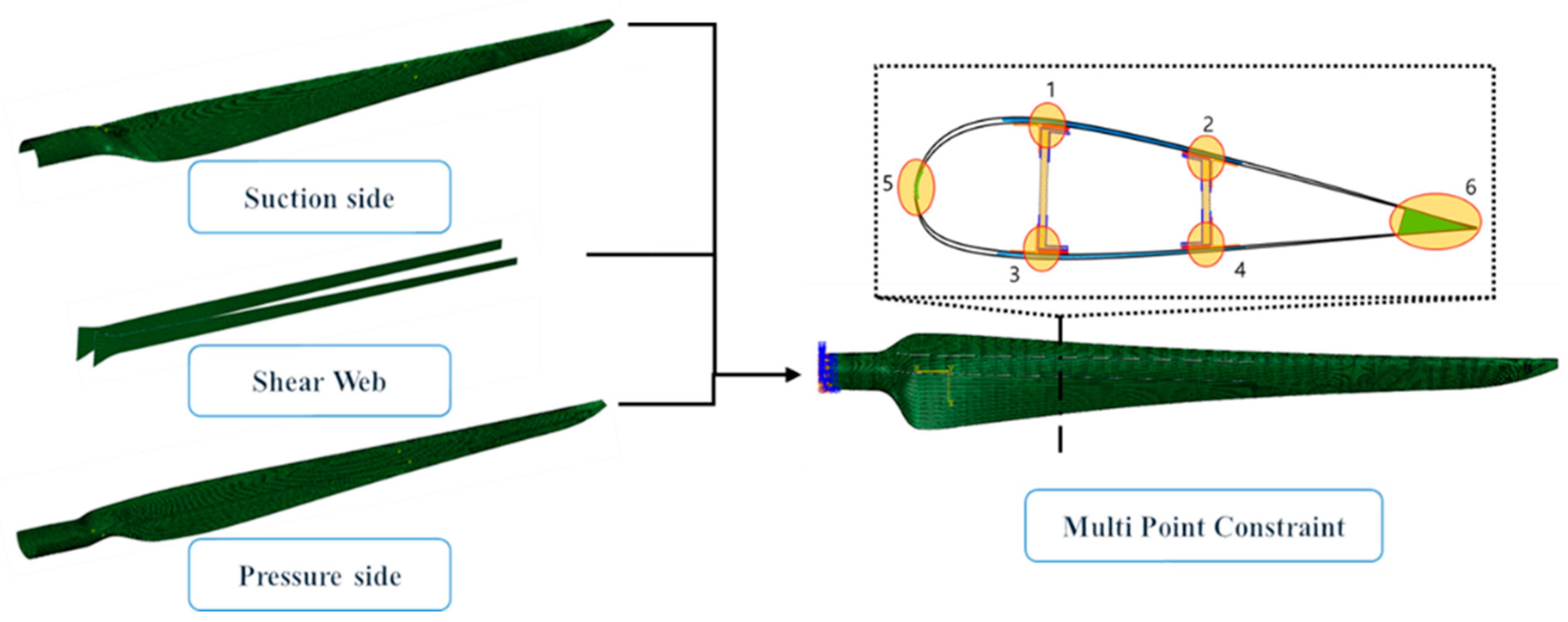
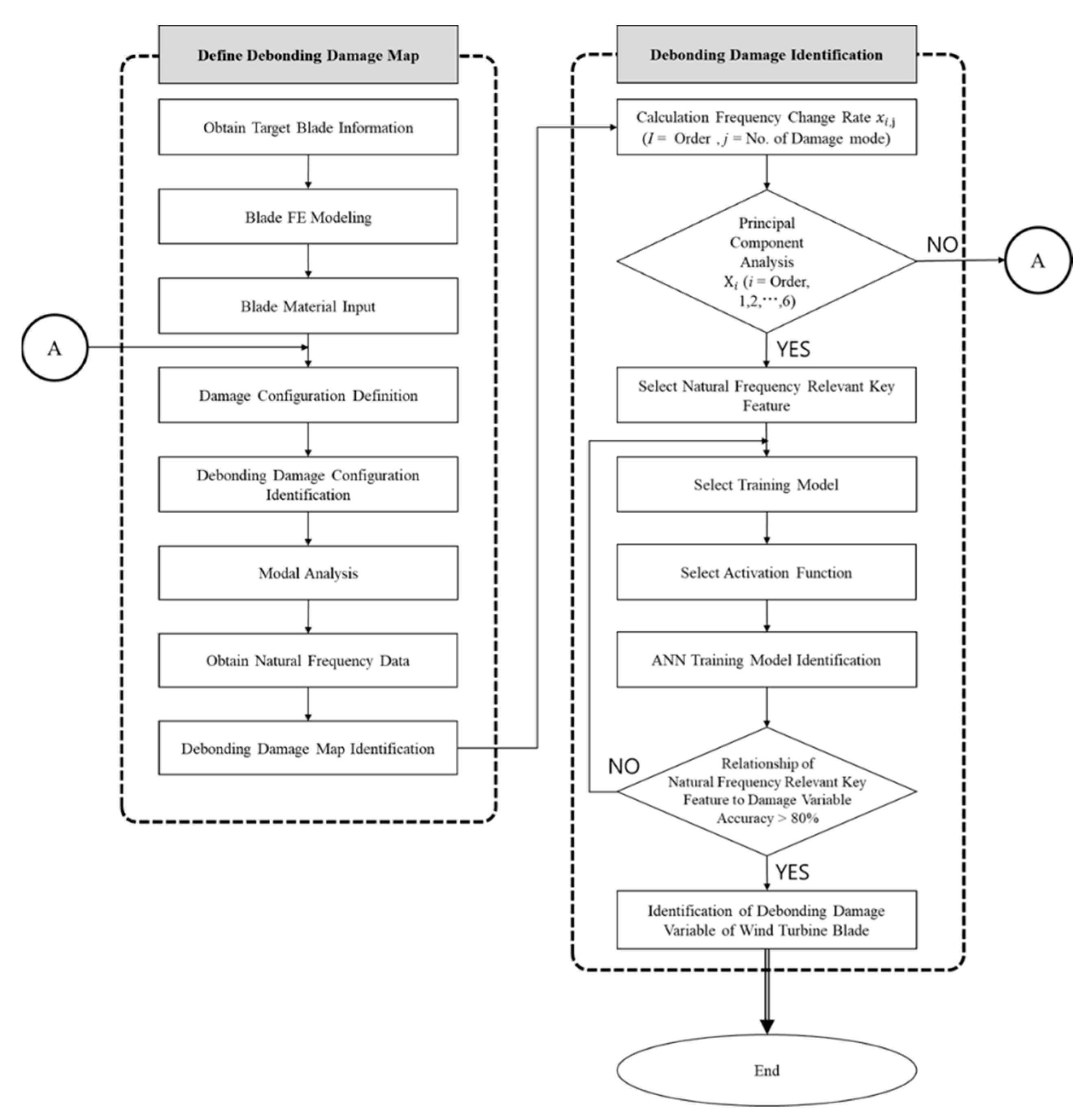
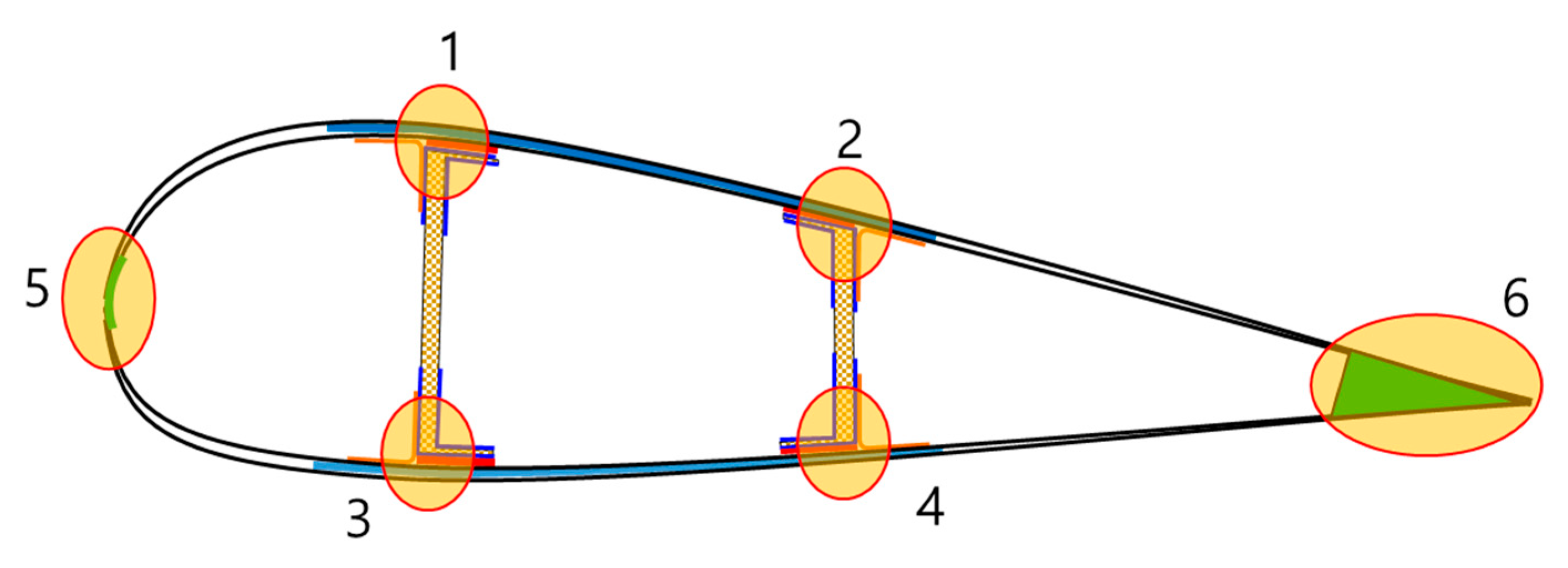





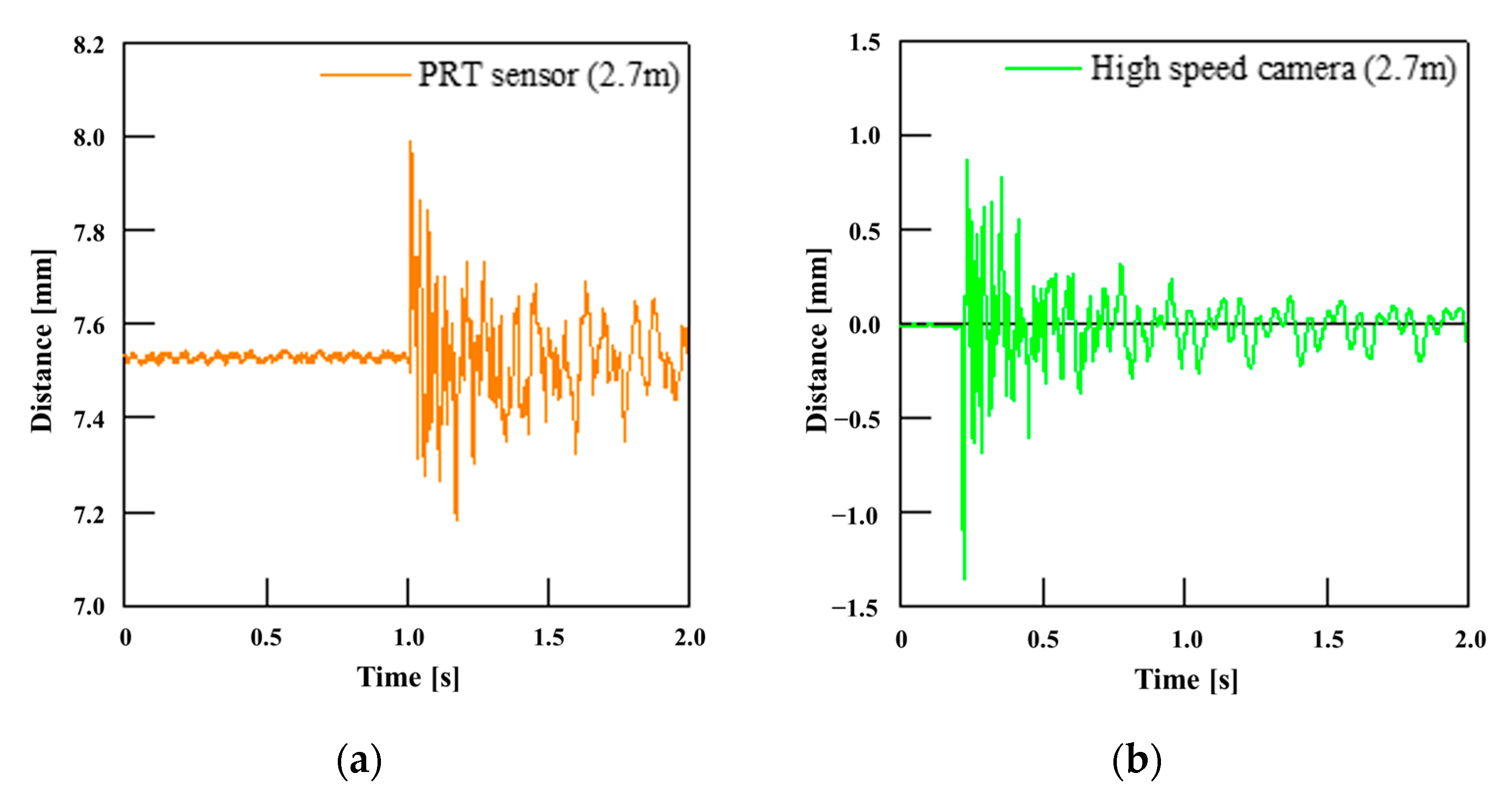



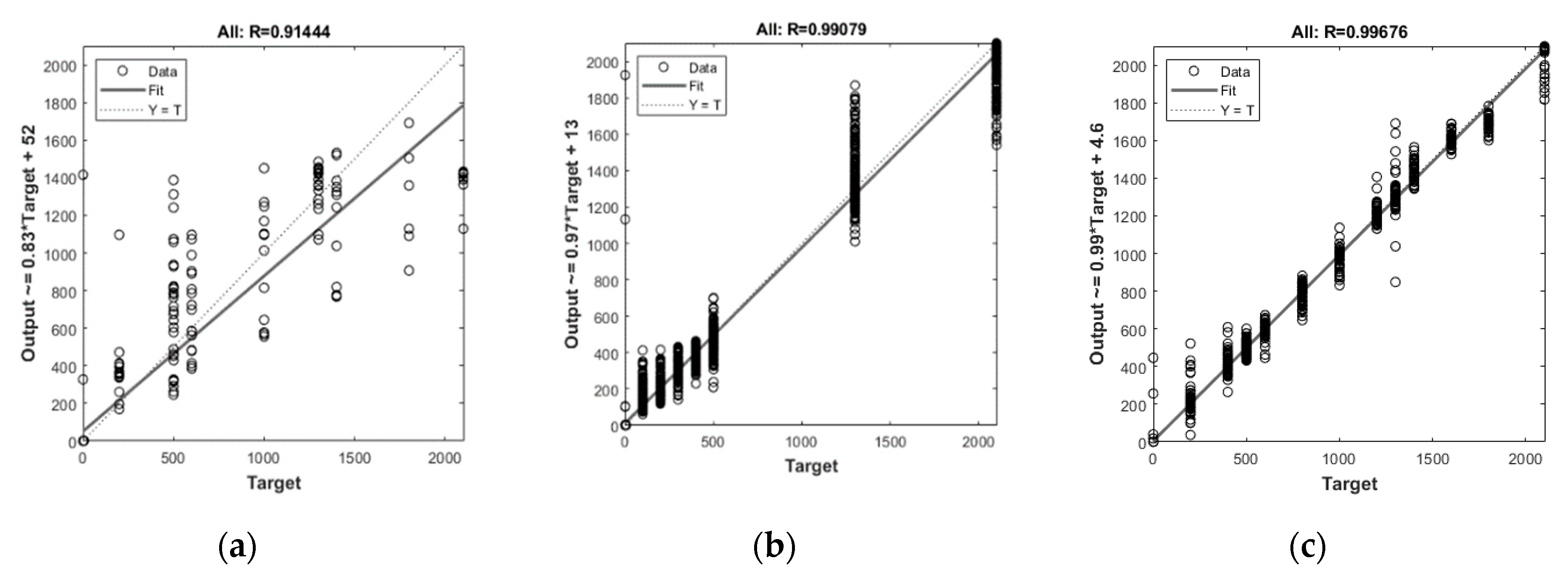
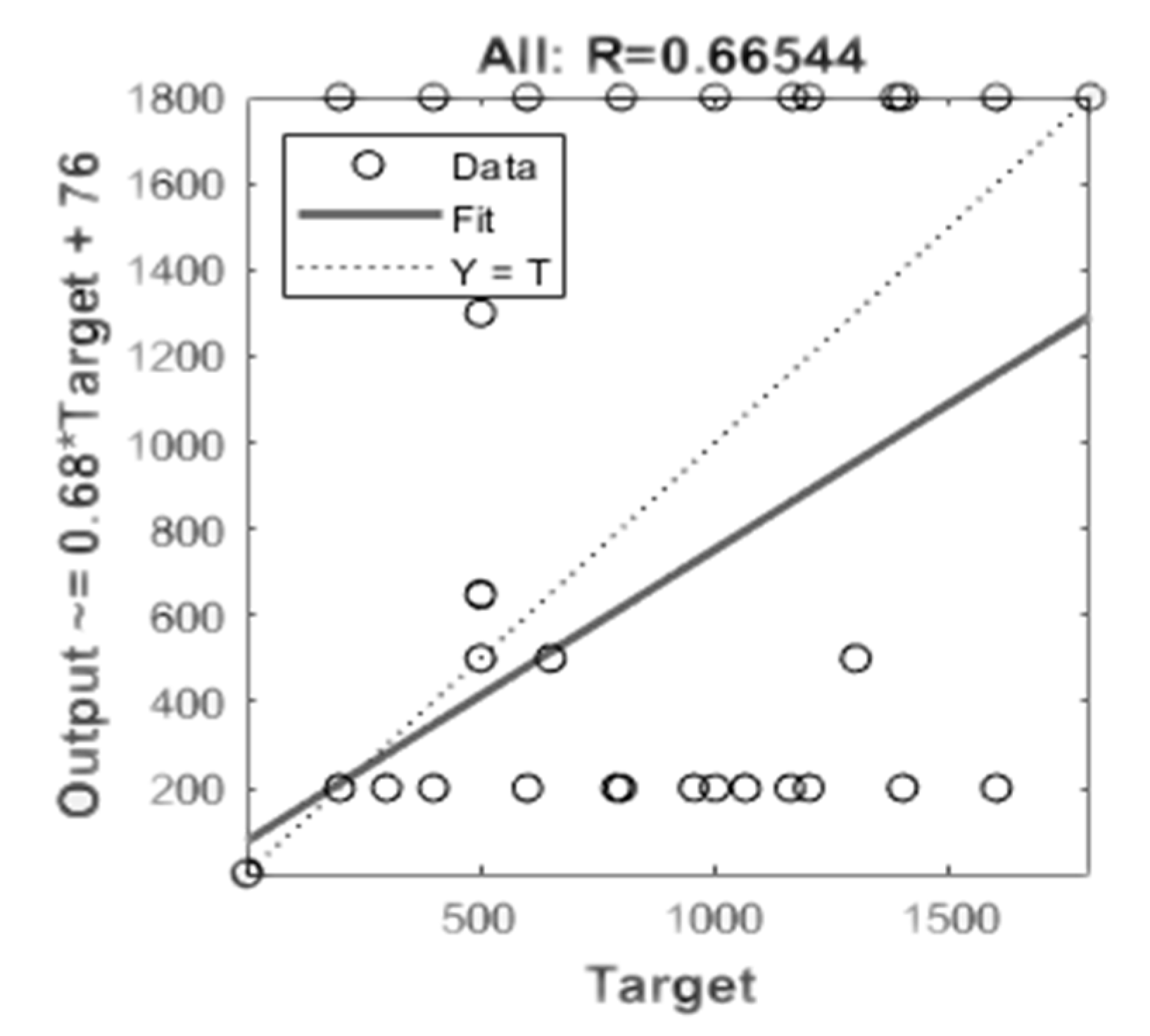
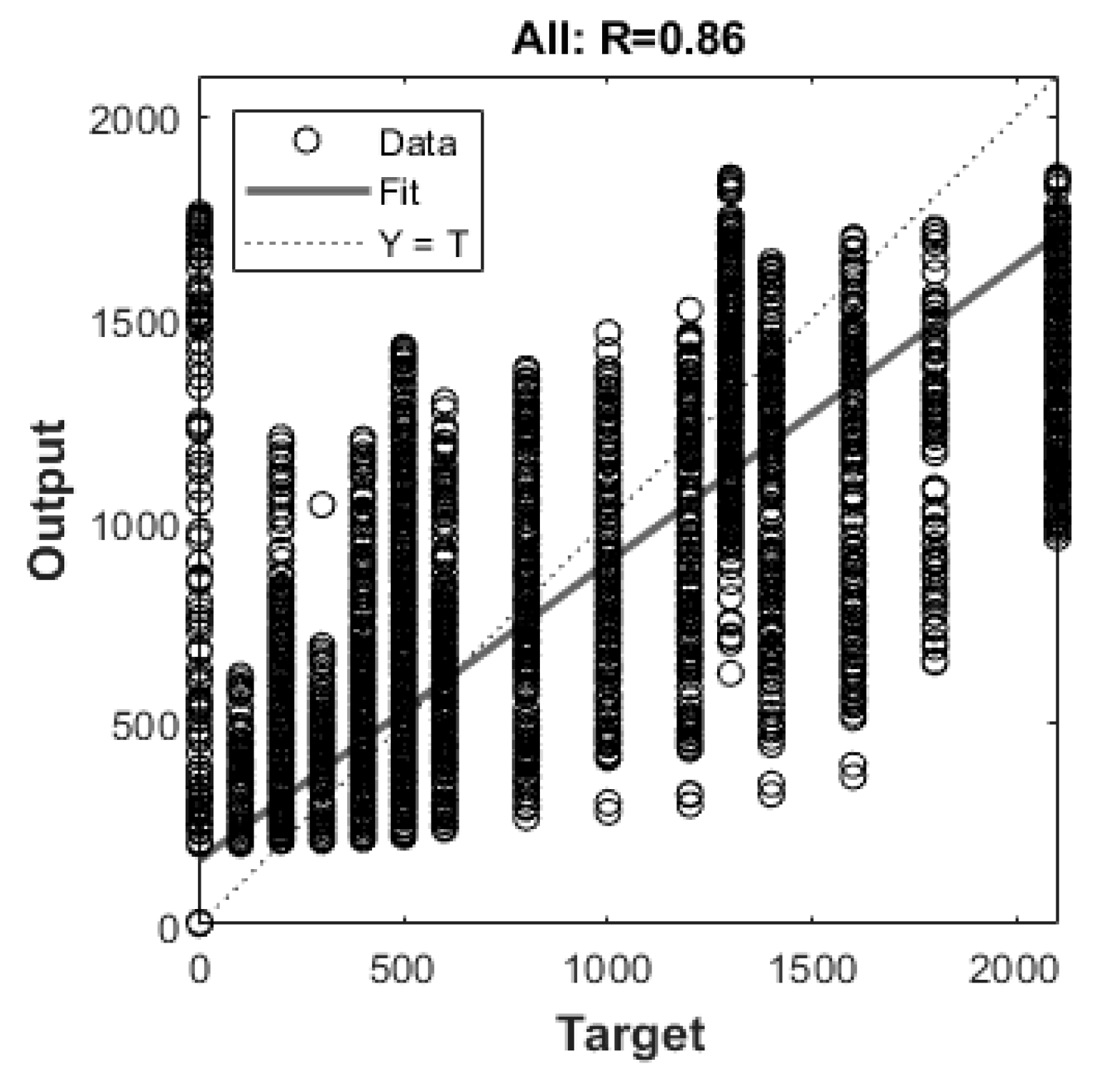
| Rated power | 20 kW |
| Cut-in wind speed | 3 m/s |
| Rated wind speed | 11 m/s |
| Cut-out wind speed | 24 m/s |
| Number of blades | 3 |
| Blade length | 4.95 m |
| Inertia location to root | 2 m |
| Number of shear web | 2 |
| Number of nodes | 41,736 | Total number of data sets | 7132 |
| Number of elements | 40,153 | Number of training data | 4992 |
| Natural frequency order | 6 | Number of testing data | 1070 |
| Bonding contact method | MPCs | Number of validation data | 1070 |
| Properties | GFRP (Glass-Fiber-Reinforced Plastic) | CFRP (Carbon-Fiber-Reinforced Plastic) | ||
|---|---|---|---|---|
| Uni-Directional [0°] | Two-Axial [±45°] | Tri-Axial [0°, ±45°] | UD | |
| Long. Elastic modulus [GPa] | 40,100 | 12,000 | 30,500 | 133,000 |
| Trans. Elastic modulus [GPa] | 12,300 | 12,000 | 15,100 | 9000 |
| Shear modulus [GPa] | 3400 | 11,000 | 7100 | 4400 |
| Long. Poisson’s ratio | 0.26 | 0.55 | 0.43 | 0.34 |
| Layer thickness [mm] | 0.91 | 0.59 | 0.91 | 0.1 |
| Properties | PRT Sensor | High-Speed Camera | Data Logger |
|---|---|---|---|
| Model | ILD 1700-100 | Photron Fastcam Mini | GTDL-360 |
| Maximum measurement rate [Hz] | 100 kHz | 2 kHz | 1 kHz |
| Mode | Frequency (PRT) [Hz] | Frequency (Camera) [Hz] |
|---|---|---|
| 1 | 4.81 | 4.82 |
| 2 | 11.76 | 11.76 |
| 3 | 16.41 | 16.40 |
| 4 | 32.91 | 32.9 |
| 5 | 50.53 | 50.5 |
| 6 | 56.3 | 56.28 |
| Input data | Natural frequency (Hz) | ||||||
| No. | 1st | 2nd | 3rd | 4th | 5th | 6th | |
| 1 | 4.63 | 12.34 | 16.03 | 33.84 | 52.18 | 54.64 | |
| 2 | 4.57 | 12 | 15.84 | 33.58 | 52.06 | 54.33 | |
| 3 | 4.54 | 11.95 | 15.78 | 33.45 | 52 | 54.16 | |
| 4 | 4.53 | 11.93 | 15.77 | 33.33 | 51.94 | 54.09 | |
| ︙ | ︙ | ︙ | ︙ | ︙ | ︙ | ︙ | |
| 7129 | 4.63 | 12.31 | 15.98 | 33.74 | 51.65 | 54.43 | |
| 7130 | 4.62 | 12.30 | 15.96 | 33.73 | 51.54 | 54.42 | |
| 7131 | 4.62 | 12.28 | 15.93 | 33.67 | 51.39 | 54.42 | |
| 7132 | 4.62 | 12.27 | 15.90 | 33.53 | 51.09 | 54.33 | |
| Target data | No. | joint 1 | location 1 (mm) | length 1 (mm) | joint 2 | location 2 (mm) | length 2 (mm) |
| 1 | 0 | 0 | 0 | 0 | 0 | 0 | |
| 2 | 1 | 500 | 200 | 0 | 0 | 0 | |
| 3 | 1 | 500 | 600 | 0 | 0 | 0 | |
| 4 | 1 | 500 | 1000 | 0 | 0 | 0 | |
| ︙ | ︙ | ︙ | ︙ | ︙ | ︙ | ︙ | |
| 7129 | 5 | 2100 | 800 | 6 | 2100 | 200 | |
| 7130 | 5 | 2100 | 800 | 6 | 2100 | 400 | |
| 7131 | 5 | 2100 | 800 | 6 | 2100 | 600 | |
| 7132 | 5 | 2100 | 800 | 6 | 2100 | 800 |
Disclaimer/Publisher’s Note: The statements, opinions and data contained in all publications are solely those of the individual author(s) and contributor(s) and not of MDPI and/or the editor(s). MDPI and/or the editor(s) disclaim responsibility for any injury to people or property resulting from any ideas, methods, instructions or products referred to in the content. |
© 2024 by the authors. Licensee MDPI, Basel, Switzerland. This article is an open access article distributed under the terms and conditions of the Creative Commons Attribution (CC BY) license (https://creativecommons.org/licenses/by/4.0/).
Share and Cite
Kim, H.; Kim, H.; Kang, K. Accuracy Improvement of Debonding Damage Detection Technology in Composite Blade Joints for 20 kW Class Wind Turbine. Mach. Learn. Knowl. Extr. 2024, 6, 1857-1870. https://doi.org/10.3390/make6030091
Kim H, Kim H, Kang K. Accuracy Improvement of Debonding Damage Detection Technology in Composite Blade Joints for 20 kW Class Wind Turbine. Machine Learning and Knowledge Extraction. 2024; 6(3):1857-1870. https://doi.org/10.3390/make6030091
Chicago/Turabian StyleKim, Hakgeun, Hyeongjin Kim, and Kiweon Kang. 2024. "Accuracy Improvement of Debonding Damage Detection Technology in Composite Blade Joints for 20 kW Class Wind Turbine" Machine Learning and Knowledge Extraction 6, no. 3: 1857-1870. https://doi.org/10.3390/make6030091




